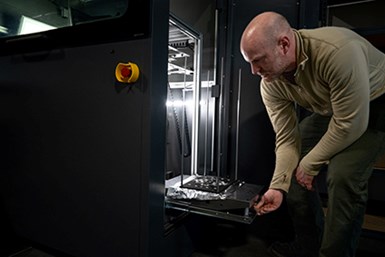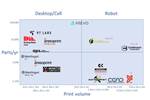Weber State applies composite-based 3D printing for aerospace support, research
The Utah-based university’s recently upgraded MARS Center installed an Impossible Objects CBAM printer to engage in projects with DOD and DOE potential.

Photo Credit: Benjamin Zack/Weber State University
Weber State University (WSU, Ogden, Utah, U.S.) is using 3D printing to advance its research on composite materials that support northern Utah’s aerospace and defense ecosystem.
Recently upgraded, the university’s Miller Advanced Research and Solutions (MARS) Center installed an Impossible Objects (Northbrook, Ill., U.S.) composite-based additive manufacturing system, or CBAM-2, which prints composite materials — currently long carbon and glass fiber fabrics with a thermoplastic matrix — that can then be used to design parts for a range of high-tech applications.
Located near Hill Air Force Base, Utah, the MARS Center brings together Weber State students and faculty with industry experts who can apply innovative solutions to real-world problems, especially in the realm of national defense.
“Composite materials are of high interest to the military, and the ability to 3D print those parts on demand with CBAM gives us an advantage to participate in more projects and recruit the best talent,” David Ferro, dean of WSU’s College of Engineering, Applied Science & Technology, notes.
The CBAM system’s carbon fiber/PEEK 3D-printed material achieves excellent mechanical properties.
Ferro says WSU has a long history with Impossible Objects and believes the new system — a leap in technology from the center’s previous CBAM printer — will be a valuable tool in aerospace research among academia, defense and commercial partners.
“We’ve used this technology to print parts for legacy aircraft, aging jets that need replacement parts or tools that aren’t in production anymore,” says Devin Young, grant writing and research specialist at WSU, who works at the MARS Center. “CBAM makes parts that are lighter and stronger than some of the other methods out there, and it does it faster.”
Young says a recent example of 3D-printed parts via Impossible Objects includes a strap that keeps first-aid kits secure inside aircraft currently flown by the U.S. Air Force (USAF).
“We’ve found a range of uses for this technology, from large aerospace companies to small local businesses,” he adds.
According to Steve Hoover, Impossible Objects CEO, the CBAM system’s carbon fiber/PEEK 3D-printed material achieves excellent mechanical properties and is a cutting-edge alternative for aluminum prototyping, tooling, spares and repairs.
“The MARS Center is at the forefront of aerospace and defense research,” Hoover says. “We’re proud that they’ve selected CBAM technology, and have already engaged in several projects that have potential for the Department of Defense [DOD], Department of Energy [DOE] and other industrial partners [including UAMMI].”
The MARS Center opened in August 2022 thanks to a $3.5 million donation from the Larry H. & Gail Miller Family Foundation. The CBAM 3D printer from Impossible Objects is among the first advanced manufacturing technologies to be installed and used at the new facility.
Related Content
-
Novel dry tape for liquid molded composites
MTorres seeks to enable next-gen aircraft and open new markets for composites with low-cost, high-permeability tapes and versatile, high-speed production lines.
-
Novel composite technology replaces welded joints in tubular structures
The Tree Composites TC-joint replaces traditional welding in jacket foundations for offshore wind turbine generator applications, advancing the world’s quest for fast, sustainable energy deployment.
-
JEC World 2022, Part 1: Highlights in sustainable, digital, industrialized composites
JEC World 2022 offered numerous new developments in composites materials, processes and applications, according to CW senior editor, Ginger Gardiner, most targeting improved sustainability for wider applications.
















